In the realm of online advertising, understanding the difference between Cost-Per-Click (CPC) and Cost-Per-Impression (CPM) is crucial for optimizing campaign strategies. CPC focuses on user engagement by charging advertisers for each click on their ads, while CPM emphasizes brand visibility by billing for every thousand impressions. Choosing the right model depends on the specific goals of your campaign, whether it’s driving traffic or enhancing brand awareness.
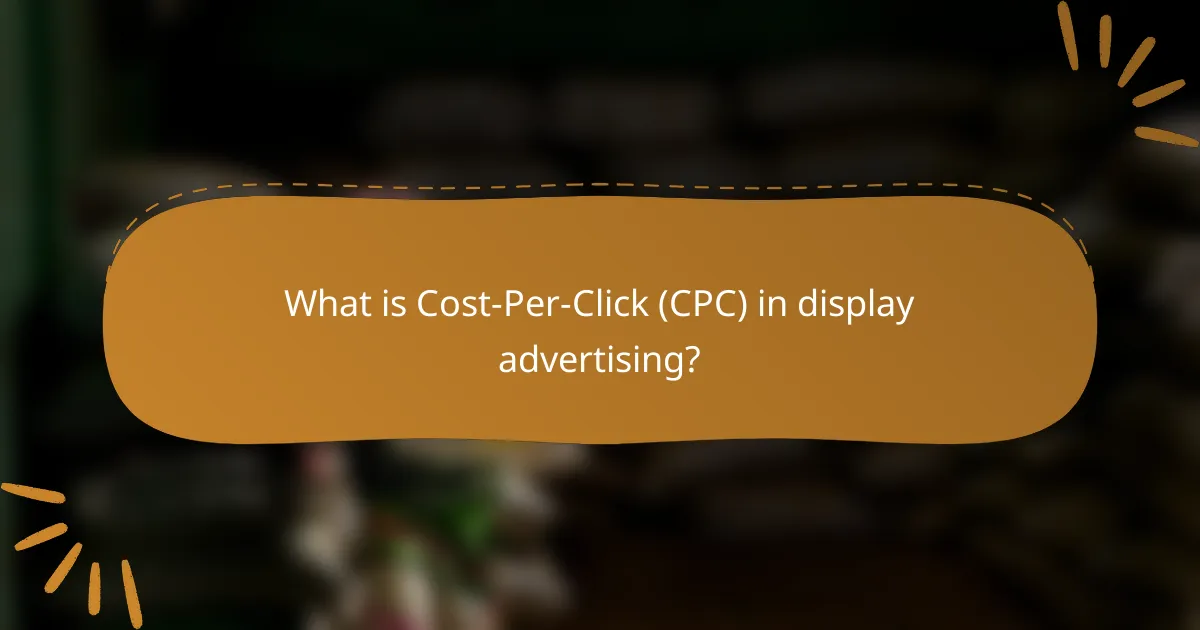
What is Cost-Per-Click (CPC) in display advertising?
Cost-Per-Click (CPC) in display advertising refers to the pricing model where advertisers pay each time a user clicks on their ad. This approach allows advertisers to directly measure the effectiveness of their campaigns based on user engagement.
CPC definition
CPC is a digital advertising model that charges advertisers for each click their ad receives. This model is commonly used in search engine advertising and display networks, where the goal is to drive traffic to a website or landing page. Advertisers set a maximum bid for how much they are willing to pay per click, and the actual cost may vary based on competition and ad placement.
Benefits of CPC
The primary benefit of CPC is that it aligns costs directly with user engagement; advertisers only pay when a potential customer shows interest by clicking the ad. This can lead to a more efficient use of advertising budgets, as funds are allocated based on performance rather than mere exposure. Additionally, CPC campaigns can be easier to track and analyze, providing clear metrics for return on investment.
Another advantage is the potential for high conversion rates. Since clicks indicate interest, CPC campaigns can drive targeted traffic to a site, increasing the likelihood of conversions compared to other models like Cost-Per-Impression (CPI).
When to use CPC
CPC is best used when the goal is to drive traffic to a website or generate leads. It is particularly effective for campaigns focused on specific actions, such as signing up for a newsletter or making a purchase. If your product or service has a clear call to action, CPC can be a suitable choice.
However, consider using CPC when you have a well-defined target audience and can create compelling ads that encourage clicks. Avoid CPC if your primary goal is brand awareness, as other models like Cost-Per-Impression may be more effective in those scenarios.
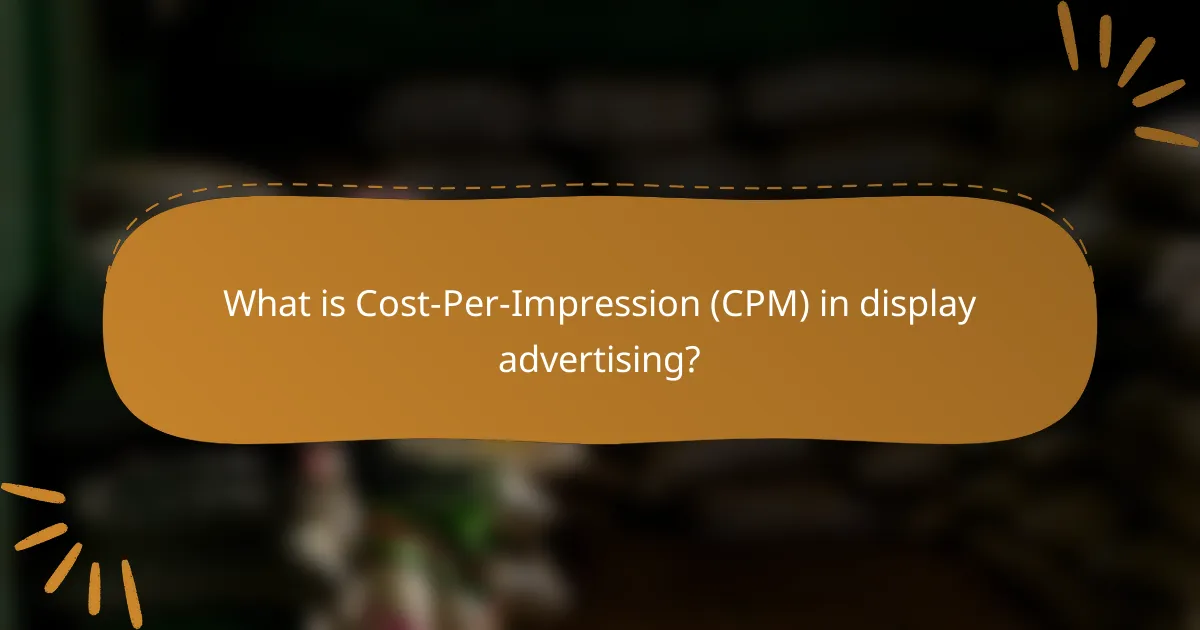
What is Cost-Per-Impression (CPM) in display advertising?
Cost-Per-Impression (CPM) is a pricing model in display advertising where advertisers pay for every thousand impressions their ad receives. This method focuses on brand visibility rather than direct clicks, making it ideal for campaigns aimed at increasing awareness.
CPM definition
CPM stands for Cost-Per-Mille, with “mille” meaning thousand in Latin. In this model, advertisers are charged a set fee for every 1,000 times their ad is displayed, regardless of whether users interact with it. This approach is commonly used in display advertising across various platforms.
Benefits of CPM
One of the primary benefits of CPM is its ability to enhance brand visibility. Since advertisers pay for impressions, they can reach a larger audience, which is particularly useful for new product launches or brand awareness campaigns. Additionally, CPM can be more cost-effective for campaigns that prioritize reach over direct engagement.
Another advantage is the simplicity of budgeting. Advertisers can easily estimate costs based on their desired reach, allowing for straightforward campaign planning. This predictability can help in allocating marketing budgets effectively.
When to use CPM
CPM is best utilized in campaigns focused on brand awareness or visibility rather than immediate conversions. If the goal is to introduce a new product or increase brand recognition, CPM can be an effective choice. It is particularly suitable for businesses looking to reach a broad audience across various demographics.
However, advertisers should avoid using CPM for campaigns that require direct response or action, such as lead generation or sales conversions. In such cases, models like Cost-Per-Click (CPC) may yield better results. Always assess campaign objectives before choosing the pricing model to ensure alignment with marketing goals.
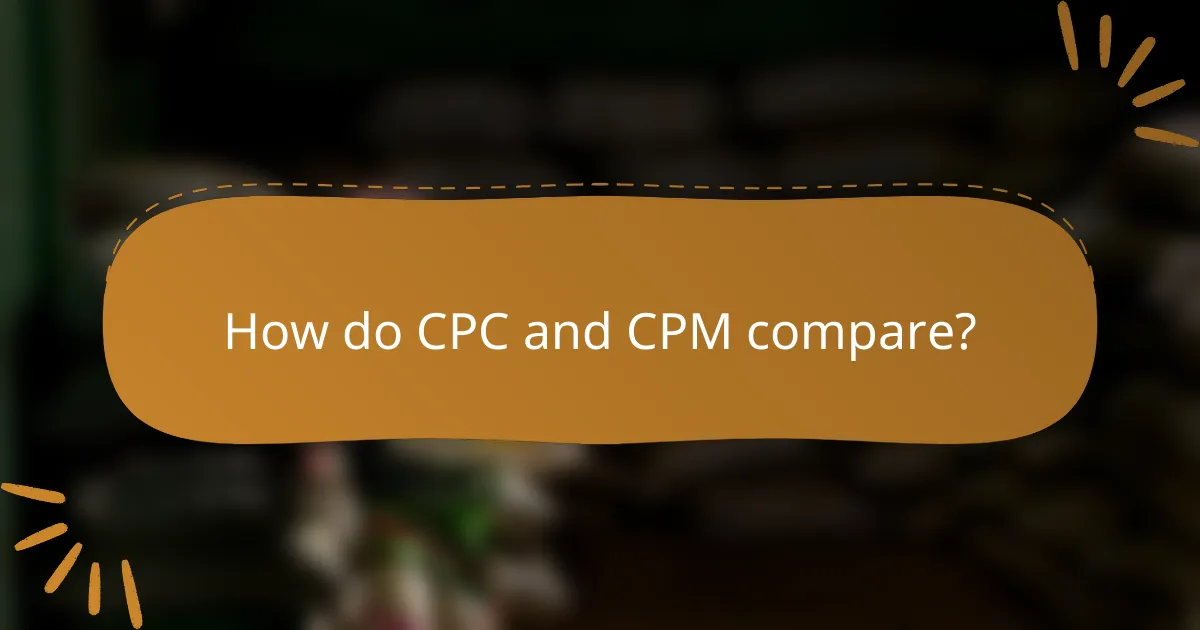
How do CPC and CPM compare?
CPC (Cost-Per-Click) and CPM (Cost-Per-Thousand Impressions) are two distinct pricing models used in online advertising. CPC charges advertisers based on the number of clicks their ads receive, while CPM charges based on the number of impressions, or views, the ads generate.
CPC vs. CPM cost structure
The cost structure for CPC is straightforward: advertisers pay only when a user clicks on their ad. This model is beneficial for campaigns focused on driving traffic or conversions. In contrast, CPM requires advertisers to pay for every thousand impressions, making it suitable for brand awareness campaigns where visibility is the primary goal.
For example, if an ad costs $2.00 per click and receives 100 clicks, the total cost would be $200. Conversely, if an ad costs $5.00 CPM and generates 10,000 impressions, the total cost would be $50. Understanding these structures helps advertisers choose the right model based on their objectives.
Performance metrics comparison
When comparing performance metrics, CPC typically offers a clearer return on investment for campaigns aimed at engagement, as it directly correlates spending with user actions. In contrast, CPM can be more challenging to measure in terms of direct outcomes since it focuses on impressions rather than interactions.
Advertisers should consider metrics such as click-through rate (CTR) for CPC campaigns and reach or frequency for CPM campaigns. A high CTR indicates effective targeting and ad relevance, while reach measures how many unique users saw the ad, which is crucial for brand exposure.
Target audience considerations
Choosing between CPC and CPM also depends on the target audience. If the goal is to reach a niche audience likely to engage with the ad, CPC may be more effective. This model allows for precise targeting and budget control based on actual clicks.
On the other hand, if the aim is to build brand awareness among a broader audience, CPM can be advantageous. It allows advertisers to maximize visibility and impressions, which is essential for campaigns focused on establishing brand presence rather than immediate conversions.

Which is better for specific advertising goals?
Choosing between cost-per-click (CPC) and cost-per-impression (CPM) depends on your advertising objectives. CPC is generally more effective for driving immediate actions, while CPM is suited for building brand awareness over time.
Best for brand awareness
Cost-per-impression (CPM) is ideal for campaigns focused on brand awareness. By paying for each impression, advertisers can maximize visibility across a wide audience, making it easier to establish brand recognition. This approach is particularly beneficial for new brands or products entering the market.
When using CPM, consider targeting broad demographics to ensure your ads reach as many potential customers as possible. A good practice is to monitor engagement metrics, such as view-through rates, to gauge the effectiveness of your awareness campaigns.
Best for direct response
Cost-per-click (CPC) is the preferred model for direct response campaigns, where the goal is to drive immediate actions like purchases or sign-ups. With CPC, you only pay when a user clicks on your ad, making it a more cost-effective option for advertisers seeking measurable results.
To optimize CPC campaigns, focus on creating compelling ad copy and strong calls to action. Regularly analyze click-through rates (CTR) to refine your targeting and improve conversion rates. Aim for a CTR above industry averages to ensure your ads are effective.
Best for retargeting campaigns
For retargeting campaigns, CPC is often more advantageous. Since these ads are shown to users who have previously interacted with your brand, the likelihood of conversion is higher, making CPC a cost-efficient choice. You pay only when a user clicks, which aligns well with the goal of converting interested prospects.
When implementing retargeting, segment your audience based on their previous interactions to tailor your messaging effectively. Monitor performance metrics closely, as retargeting campaigns can yield higher conversion rates compared to standard display ads, often exceeding 10% in some industries.
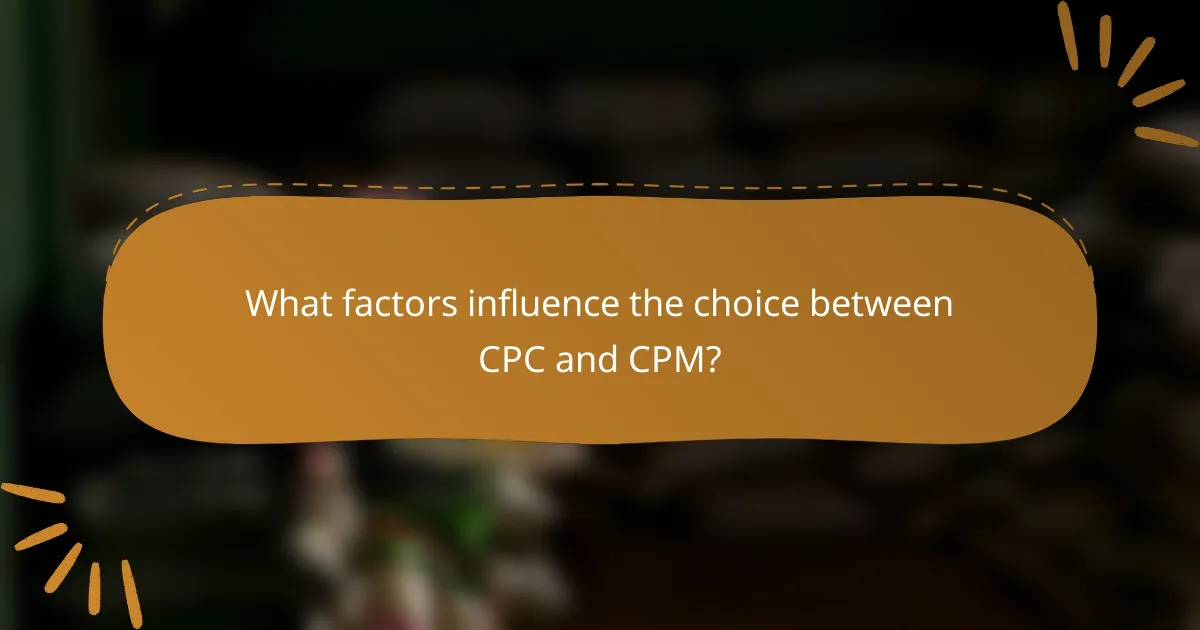
What factors influence the choice between CPC and CPM?
The choice between Cost-Per-Click (CPC) and Cost-Per-Impression (CPM) depends on several factors, including campaign goals, budget limitations, and ad placement strategies. Understanding these elements can help advertisers select the most effective pricing model for their needs.
Campaign objectives
Campaign objectives play a crucial role in deciding between CPC and CPM. If the goal is to drive traffic to a website or generate leads, CPC is often more suitable since advertisers only pay when users click on their ads. Conversely, if the aim is to increase brand awareness or reach a broad audience, CPM may be more effective as it focuses on impressions rather than clicks.
For example, a new product launch may benefit from a CPM model to maximize visibility, while a promotional campaign targeting specific conversions would likely favor CPC.
Budget constraints
Budget constraints significantly influence the choice between CPC and CPM. Advertisers with limited budgets may prefer CPC because it allows for more control over spending, as they only pay for actual clicks. In contrast, CPM can lead to higher costs if impressions do not translate into clicks or conversions.
It’s advisable to set a clear budget and evaluate potential ROI for each model. For instance, if an advertiser has a budget of $500, they should calculate how many clicks or impressions they can realistically achieve under each pricing structure.
Ad placement strategies
Ad placement strategies also impact the decision between CPC and CPM. If ads are placed in high-traffic areas where visibility is guaranteed, CPM might be advantageous. However, if the placements are less certain, CPC can provide a safer option by ensuring payment only when users engage with the ad.
Additionally, testing different placements with both models can provide insights into which strategy yields better performance. For example, running a split test with a portion of the budget on CPC and another on CPM can help determine the most effective approach for a specific audience or platform.
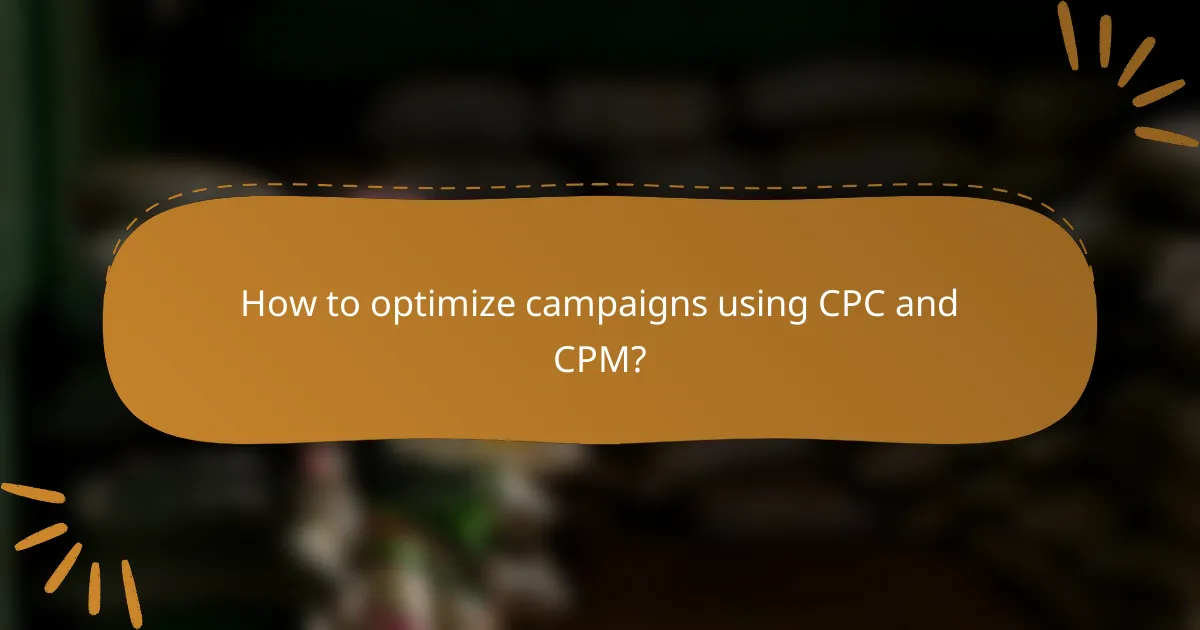
How to optimize campaigns using CPC and CPM?
To optimize campaigns using Cost-Per-Click (CPC) and Cost-Per-Impression (CPM), it’s essential to understand your campaign goals and target audience. CPC is ideal for driving traffic and conversions, while CPM is better for brand awareness and visibility.
Understanding your campaign goals
Defining your campaign goals is crucial in deciding between CPC and CPM. If your objective is to generate immediate traffic or leads, CPC is the preferred choice as you only pay when someone clicks on your ad. Conversely, if your aim is to increase brand exposure and reach a larger audience, CPM allows you to pay for impressions, making it more cost-effective for visibility-focused campaigns.
Target audience considerations
Your target audience significantly influences the choice between CPC and CPM. For niche markets with high conversion potential, CPC can yield better returns as it focuses on users who are more likely to engage. In contrast, for broader audiences where brand recognition is key, CPM can be advantageous, allowing you to reach more users at a lower cost per view.
Budget allocation strategies
When optimizing your budget, consider allocating funds based on your campaign’s performance metrics. Start with a test budget to evaluate which model yields better results for your specific goals. For example, if CPC campaigns consistently outperform CPM in driving conversions, consider shifting more budget towards CPC to maximize ROI.
Monitoring and adjusting campaigns
Regularly monitor your campaigns to assess their effectiveness. Use analytics tools to track key performance indicators such as click-through rates (CTR) and conversion rates. If you notice that one model is underperforming, be prepared to adjust your strategy. For instance, if a CPM campaign isn’t generating sufficient engagement, consider switching to a CPC model to drive more targeted traffic.
